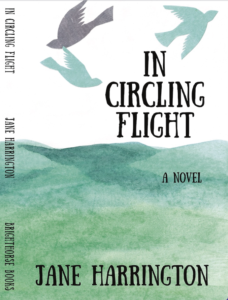
 Review by Jane Ward
Review by Jane Ward
In Circling Flight is the first novel by Jane Harrington, short story author and professor of English at Washington & Lee University. In 2019, the manuscript was awarded the Brighthorse Prize, an honor which included publication in 2022. In this novel, Harrington has turned her considerable talents of observation and storytelling to a corner of Appalachia where some locals live in seasonal harmony with the land while others are driven from it by the devastation caused by mountaintop removal mining.
In “Book One: Way Out Farm,” we meet Leda, occasional tutor and novice goat farmer, living alone on the farm she had shared with her husband, John, until his sudden death months earlier. Leda tells details of her widowed life through conversation with her absent husband, however, we come to understand that her grief is complicated by John’s history as an abused child and the anguish he suffered that ultimately overwhelmed his will to live. Early on, she relates to John that she has fallen in love with a shelter dog and has brought him home for companionship—a sign that she is poised to move past tragedy and isolation.
I kneel next to him sometimes on the hearth, his shadow pooled strangely around him from the bright flames lapping the sooty walls of the firebox. I rest my cheek against his side for as long as it takes to feel a pulse or a dream shudder, any sign that he is alive. (20)
Shortly after welcoming the dog, Leda begins teaching at the local college and meets El, a troubled student who needs friendship as much as Leda needs to offer it. Later, when delivering food boxes to some locals, she meets Shannon Sullivan and her two children, as well as Shannon’s cousin Sean, a combat veteran still haunted by images of war. Shannon and her kids live in the hollow beneath a coal-stripped mountain, their home and the natural world around them threatened by the suffocating, muddy run-off. As friendships develop and deepen, a community of people who care for each other forms. By the third part of Book One, Leda is no longer speaking to John about her life; she is living it.
…I consider a repeat performance of what I did this morning soon after I got out of bed—dance with abandon throughout the house—but I let go the urge, pull off my apron, hang it over a chair, and wander out onto the porch…I take a last look at today’s sun. A Forever sun, I’ve been calling it all day. Not one cloud obscured it in its entire journey across the sky. (132)
In “Book Two: Sullivan’s Holler,” the story abruptly shifts focus from Leda to Shannon and her fight against the coal companies that are destroying her homeland. Shannon leaves her family home with her children and new partner, Dot, for a healthier place to live. Along the way, they organize environmental rallies and petitions for alternative energy sources. To occupy her son while they resettle, Shannon tells him the history of their Sullivan ancestors in Ireland and of the potato blight that led to widespread famine, death, and emigration.
The inclusion of the Irish storyline, with its tales of hardship and the supernatural world of Tir Na Nog, may strike readers as curious at first. But the parallels between the Irish famine and the destruction of land in Appalachia are soon very clear: precious homeland was made uninhabitable; industry enriched a select few while impoverishing a good many others.
Still, such heavy themes are handled deftly, often interspersed with humor that breathes air into the spaces between them. It’s a joy to read the witty double entendres that pass between Leda and Shannon and the quirky banter that Shannon shares with her son, Mitch—reminders that within the political causes are people living their lives.
Also constant throughout the novel is reverence for the natural world, a beautiful place worth preserving and improving.
And as the green linnet completes its circle and passes over Whiskey Mountain to return to thehollow, to the people with heads tipped to the sky, the sound of water flowing down the rocks toward them fills the world. (280)
In this era of climate woes and environmental awareness, In Circling Flight provides readers with a richly drawn fictional world through which we may gain understanding of our own relationship with, and responsibility to, the people and planet that provide us shelter.
In Circling Light by Jane Harrington
Brighthorse Books, February 2022
Paperback $12.99
ISBN-13 978-1-944467-25-8
Jane Alessandrini Ward is the author of In the Aftermath (She Writes Press, 2021), The Mosaic Artist (2011) and Hunger (Forge, 2001). She has been a contributing writer for an online regional and seasonal food magazine and a blogger and occasional host of cooking videos for an internet recipe resource. Jane lives in Massachusetts. To learn more, visit janeaward.com.
